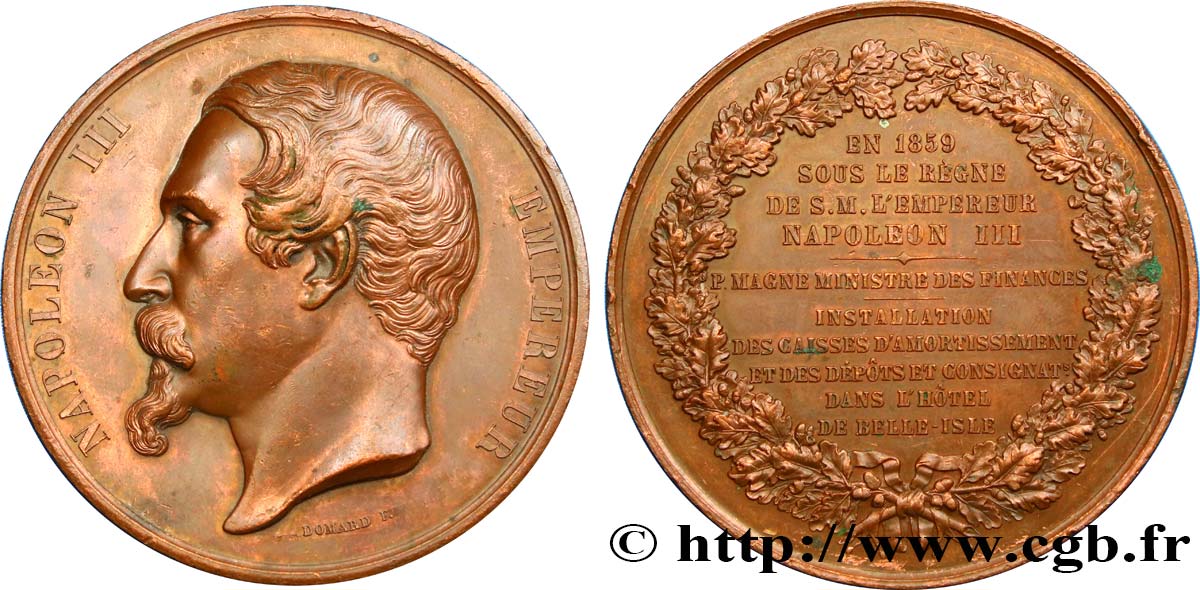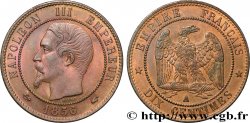E-auction 306-225278 - fme_412179 - SECOND EMPIRE Médaille, Installation de la Caisse des Dépôts et Consignations dans l’hôtel de Belle-Isle
Чтобы принять участие в торгах, вы должны войти в систему и стать подтвержденным участником аукциона. Войдите, чтобы сделать ставку. Ваш аккаунт будет подтвержден в течение 48 часов. Не ждите до закрытия торгов, чтобы зарегистрироваться.Сделав ставку на данный товар, вы вступаете в юридическое соглашение на покупку выбранного товара и нажатием кнопки «Сделать ставку» подтверждаете принятие вами условий интернет-аукционов cgb.fr.
Ставка может бить сделана только в полном эквиваленте евро. Торги закроются согласно времени, указанному в описании товара, все ставки, сделанные после закрытия торгов, учитываться не будут. Не следует откладывать предложение вашей ставки до последнего момента, так как система может не успеть обработать вашу заявку, и ваша ставка не будет принята. Более детальную информацию вы найдёте здесь: FAQ по интернет-аукционам.
БЕСПЛАТНО.
БЕСПЛАТНО.
| Оценить : | 150 € |
| Цена : | 44 € |
| Максимальная предлагаемая цена : | 46 € |
| Конец торгов : | 25 February 2019 18:27:00 |
| Участников : | 9 Участников |
Тип Médaille, Installation de la Caisse des Dépôts et Consignations dans l’hôtel de Belle-Isle
Дата: 1859
Монетный двор / Город: 75 - Paris
Металл: copper
Диаметр: 68 mm
Ориентация осей монеты: 12 h.
Гравер DOMARD Joseph-François (1792-1858)
Вес: 172 g.
Век: lisse + main CUIVRE
Пуансон: MAIN Cuivre
Комментарии о состоянии
Exemplaire nettoyé. Présence de coups et rayures
Лицевая сторона
Аверс: легенда: NAPOLÉON III - EMPEREUR.
Аверс: описание: Tête nue de Napoléon III à gauche.
Обратная сторона
Реверс: легенда: EN 1859 / SOUS LE RÈGNE / DE S. M. L’EMPEREUR / NAPOLÉON III / P. MAGNE MINISTRE DES FINANCES / INSTALLATION / DES CAISSES D’AMORTISSEMENT / ET DES DÉPÔTS ET CONSIGNAS / DANS L’HÔTEL / DE BELLE-ISLE.
Реверс: Описание: Légende en 10 lignes dans une couronne de chêne.
Комментарий
Joseph-François Domard (1792 - 1858) était un graveur médailleur et graveur de monnaies. Il fut élève de l'École nationale supérieure des beaux-arts de Paris en 1810. En 1810 il obtint le deuxième Prix de Rome catégorie Gravure en médaille et pierre fine.
Domard est particulièrement connu pour sa gravure de la série monétaire de Louis-Philippe.
A l’origine de cette institution se distingue Louis-Emmanuel Corvetto, ministre des Finances de Louis XVIII. Il propose en 1816 de créer cet établissement pour financer à des taux raisonnables les emprunts contractés par l’Etat. Sur une suggestion du banquier Benjamin Delessert, les dépôts sur les livrets de Caisse d’Epargne passent en 1837 sous le contrôle de la Caisse des Dépôts et Consignations.
Au cours du XIXe siècle, les fonds accumulés par cette institution vont contribuer au développement industriel de la France. Au début du XXe siècle, la Caisse des Dépôts s’investit dans la construction de logements sociaux, vocation qu’elle a conservé jusqu’à aujourd’hui.
La Caisse des Dépôts et Consignations occupe plusieurs hôtels particuliers, à proximité du musée d’Orsay. Son siège se situe au n° 56 rue de Lille dans l’hôtel de Belle-Isle. En 1720, le comte Charles Fouquet de Belle-Isle (1684-1761), petit-fils du surintendant Nicolas Fouquet, confie la construction de son hôtel à François Bruant. A sa mort en 1761, il le lègue au Roi Louis XV, en échange de l’hôtel du duc de Praslin. En 1857, la demeure est acquise par la Caisse des Dépôts et Consignations qui y installe son siège. Durant la Commune de Paris, l’édifice est très endommagé et les décors intérieurs brûlés. Il est partiellement reconstruit et surélevé en 1871-1873 par l’architecte Hyppolite-Emile Eudes..
Joseph-François Domard (1792 - 1858) was a medalist and coin engraver. He was a student at the National School of Fine Arts in Paris in 1810.. In 1810 he won the second Prix de Rome in the category of Medal and Fine Stone Engraving..
Domard is particularly known for his engraving of the Louis-Philippe monetary series.
At the origin of this institution stands Louis-Emmanuel Corvetto, Minister of Finance of Louis XVIII.. In 1816, he proposed creating this establishment to finance loans contracted by the State at reasonable rates.. On the suggestion of banker Benjamin Delessert, deposits in Caisse d'Epargne savings accounts came under the control of the Caisse des Dépôts et Consignations in 1837..
During the 19th century, the funds accumulated by this institution contributed to the industrial development of France.. At the beginning of the 20th century, the Caisse des Dépôts became involved in the construction of social housing, a vocation it has retained to this day..
The Caisse des Dépôts et Consignations occupies several private mansions, near the Orsay Museum. Its headquarters are located at 56 rue de Lille in the Hôtel de Belle-Isle. In 1720, Count Charles Fouquet de Belle-Isle (1684-1761), grandson of Superintendent Nicolas Fouquet, entrusted the construction of his hotel to François Bruant. On his death in 1761, he bequeathed it to King Louis XV, in exchange for the Duke of Praslin's hotel.. In 1857, the residence was acquired by the Caisse des Dépôts et Consignations, which established its headquarters there.. During the Paris Commune, the building was badly damaged and the interior decorations burned.. It was partially rebuilt and raised in 1871-1873 by the architect Hyppolite-Emile Eudes.
Domard est particulièrement connu pour sa gravure de la série monétaire de Louis-Philippe.
A l’origine de cette institution se distingue Louis-Emmanuel Corvetto, ministre des Finances de Louis XVIII. Il propose en 1816 de créer cet établissement pour financer à des taux raisonnables les emprunts contractés par l’Etat. Sur une suggestion du banquier Benjamin Delessert, les dépôts sur les livrets de Caisse d’Epargne passent en 1837 sous le contrôle de la Caisse des Dépôts et Consignations.
Au cours du XIXe siècle, les fonds accumulés par cette institution vont contribuer au développement industriel de la France. Au début du XXe siècle, la Caisse des Dépôts s’investit dans la construction de logements sociaux, vocation qu’elle a conservé jusqu’à aujourd’hui.
La Caisse des Dépôts et Consignations occupe plusieurs hôtels particuliers, à proximité du musée d’Orsay. Son siège se situe au n° 56 rue de Lille dans l’hôtel de Belle-Isle. En 1720, le comte Charles Fouquet de Belle-Isle (1684-1761), petit-fils du surintendant Nicolas Fouquet, confie la construction de son hôtel à François Bruant. A sa mort en 1761, il le lègue au Roi Louis XV, en échange de l’hôtel du duc de Praslin. En 1857, la demeure est acquise par la Caisse des Dépôts et Consignations qui y installe son siège. Durant la Commune de Paris, l’édifice est très endommagé et les décors intérieurs brûlés. Il est partiellement reconstruit et surélevé en 1871-1873 par l’architecte Hyppolite-Emile Eudes..
Joseph-François Domard (1792 - 1858) was a medalist and coin engraver. He was a student at the National School of Fine Arts in Paris in 1810.. In 1810 he won the second Prix de Rome in the category of Medal and Fine Stone Engraving..
Domard is particularly known for his engraving of the Louis-Philippe monetary series.
At the origin of this institution stands Louis-Emmanuel Corvetto, Minister of Finance of Louis XVIII.. In 1816, he proposed creating this establishment to finance loans contracted by the State at reasonable rates.. On the suggestion of banker Benjamin Delessert, deposits in Caisse d'Epargne savings accounts came under the control of the Caisse des Dépôts et Consignations in 1837..
During the 19th century, the funds accumulated by this institution contributed to the industrial development of France.. At the beginning of the 20th century, the Caisse des Dépôts became involved in the construction of social housing, a vocation it has retained to this day..
The Caisse des Dépôts et Consignations occupies several private mansions, near the Orsay Museum. Its headquarters are located at 56 rue de Lille in the Hôtel de Belle-Isle. In 1720, Count Charles Fouquet de Belle-Isle (1684-1761), grandson of Superintendent Nicolas Fouquet, entrusted the construction of his hotel to François Bruant. On his death in 1761, he bequeathed it to King Louis XV, in exchange for the Duke of Praslin's hotel.. In 1857, the residence was acquired by the Caisse des Dépôts et Consignations, which established its headquarters there.. During the Paris Commune, the building was badly damaged and the interior decorations burned.. It was partially rebuilt and raised in 1871-1873 by the architect Hyppolite-Emile Eudes.








 Cообщить об ошибке
Cообщить об ошибке Распечатать страницу
Распечатать страницу Отправить мой выбор
Отправить мой выбор Задать вопрос
Задать вопрос Consign / sell
Consign / sell
 Информация
Информация












